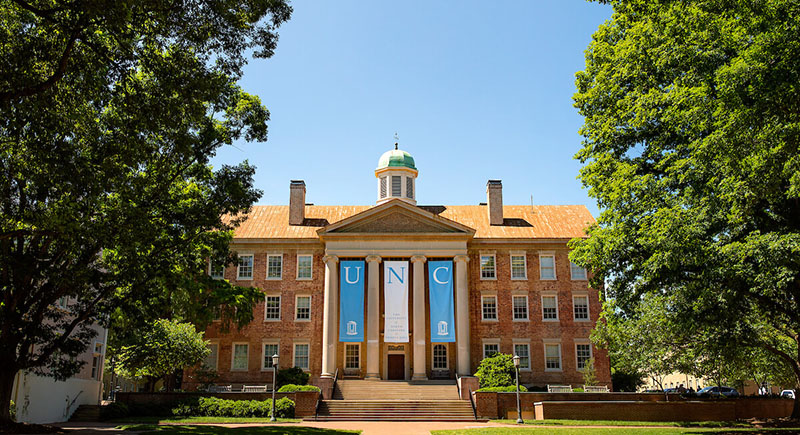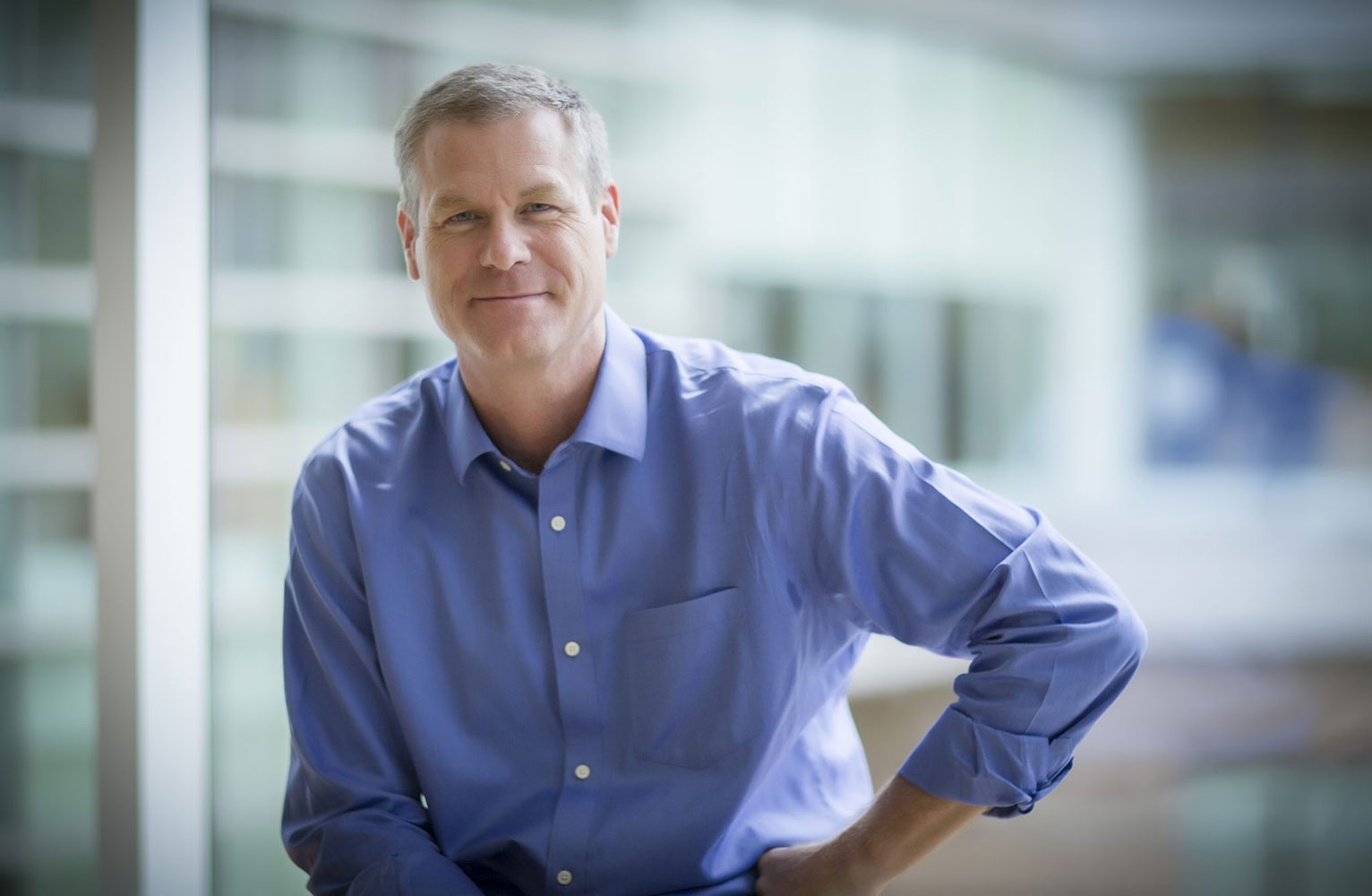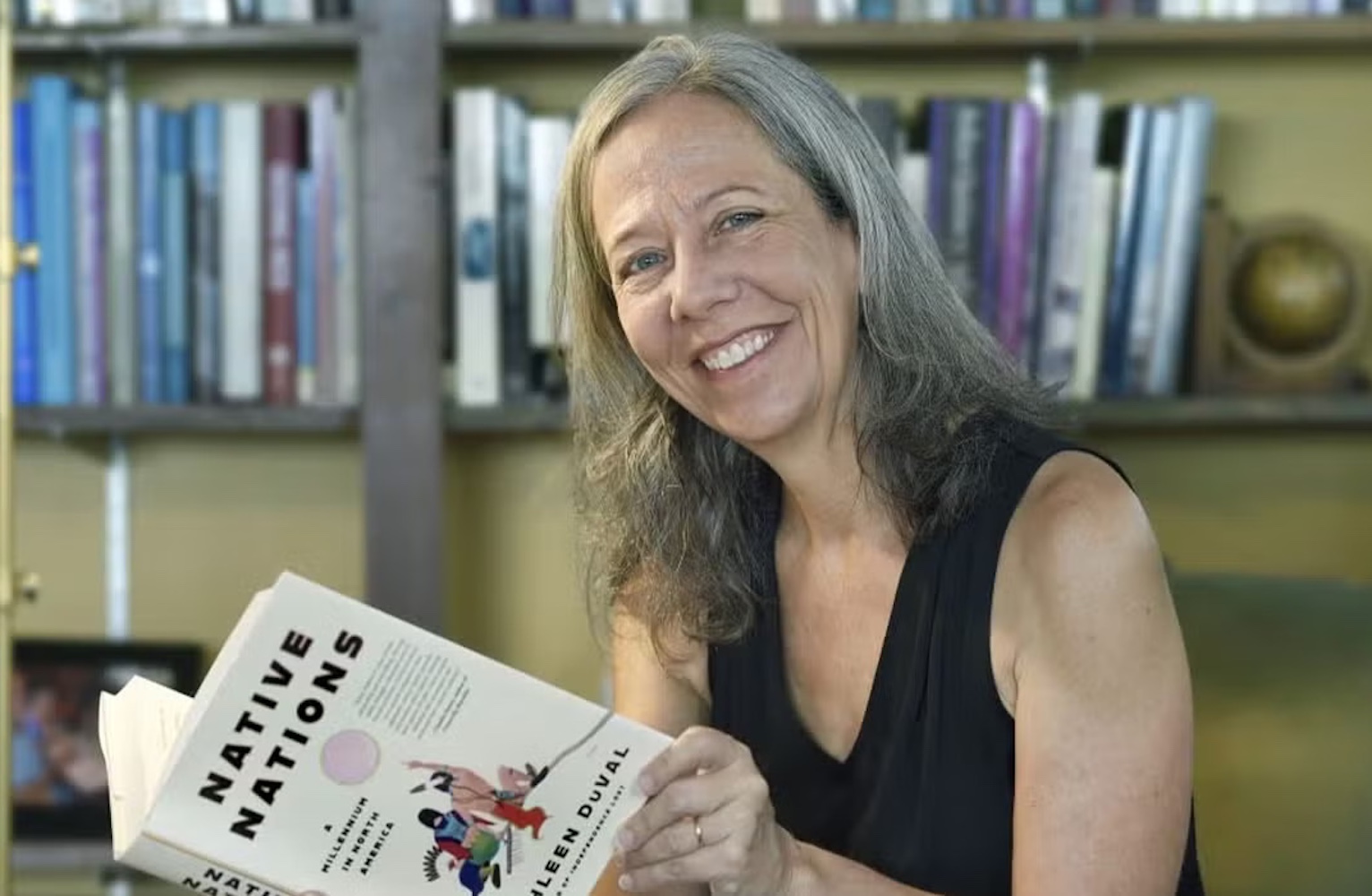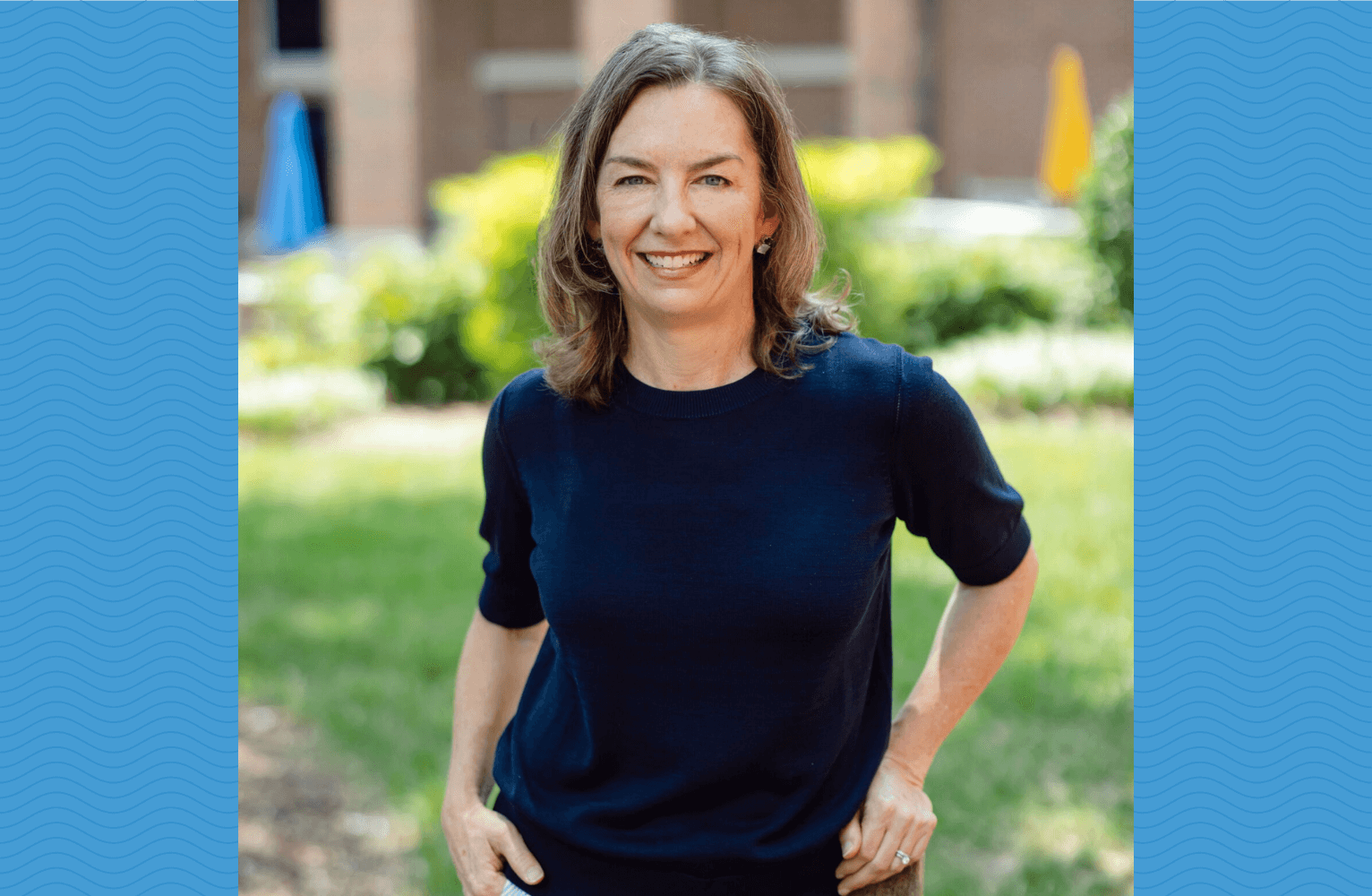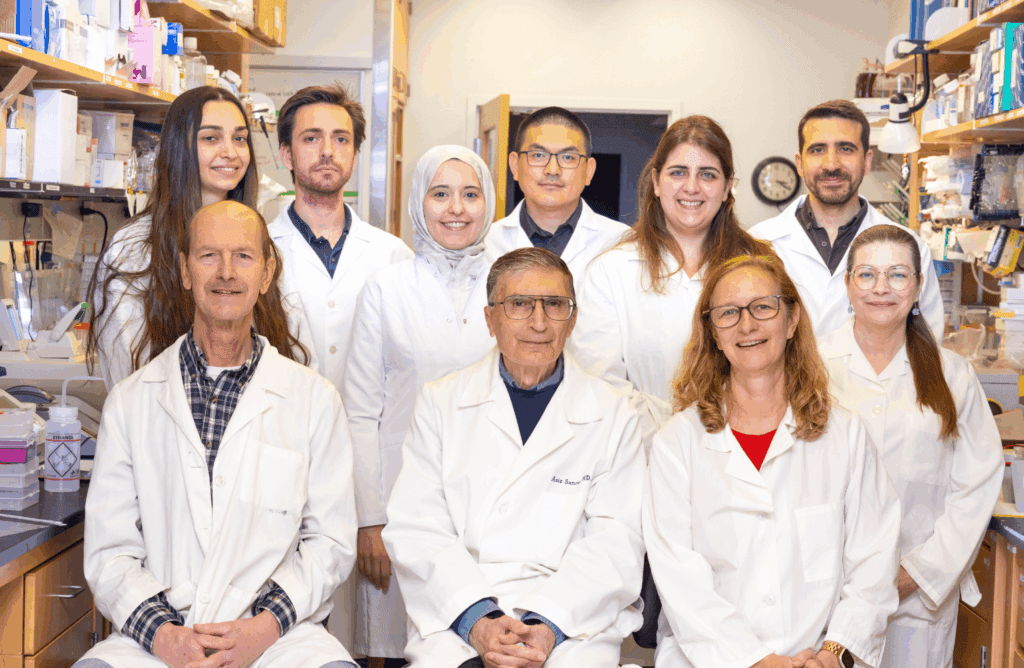
Dr. Aziz Sancar with his lab members. (Photo by Seth Foley)
A decade after winning the Nobel Prize, the UNC professor continues to push the boundaries of discovery while inspiring the next generation and building cultural bridges between the U.S. and Türkiye.
By Kendall Daniels Rovinsky, UNC Health | UNC School of Medicine
A decade after earning the Nobel Prize in Chemistry, UNC School of Medicine professor Aziz Sancar, MD, PhD, shows no signs of hanging up his lab coat.
At 79-years-old, he continues to teach molecular biology to undergraduate Tar Heels, advance cancer research, and invest in Carolina Turk Evi, a community center for Turkish graduate students and visiting scholars.
Where some might slow down or retire altogether after achieving the most prestigious award in science, Dr. Sancar remains a humble scientist; one who continues to devote his life to scientific discovery and help future researchers excel in their careers.
Most recently, his lab discovered a new biochemical approach to treat brain tumors.
Winning the Nobel
Along with researchers Tomas Lindahl and Paul Modrich, PhD, Dr. Sancar received the Nobel Prize in Chemistry in 2015 for his groundbreaking work on DNA repair.
His research mapped out a complex, but crucial, biological process called nucleotide excision repair in which proteins cut out damaged DNA segments and replace them with new ones. The revolutionary findings provided an explanation for how cells protect and repair themselves after sustaining DNA damage such as that received from ultraviolet (UV) radiation caused by exposure to sunlight.
Sancar’s discovery caused a ripple effect in numerous scientific fields, answering many questions on how DNA damage contributes to genetic mutations, cancer, and neurological disorders.
The Ripple Effect
DNA repair removes and corrects damage caused by chemical exposures and ultraviolet radiation. When this critical process fails, genetic mutations build up. This ultimately disrupts genes that regulate cell growth and division and drive cancer growth.
Dr. Sancar’s research has centered on uncovering the main molecules that carry out the disruption. Towards the beginning of his career, he studied photolyase, a blue-light–powered enzyme, and mapped out how it repairs UV-induced DNA damage.
“It is the most beautiful enzyme,” said Sancar with a smile. “It has such a beautiful color when you hold it against the light. I was so in love with it that I laid out its mechanisms down to the picosecond. To me, this was more exciting that my work that led to the Nobel prize.”
At UNC, Dr. Sancar extended this focus on blue light to the body’s circadian rhythms. His lab discovered cryptochromes, which are proteins closely related to photolyase. Unlike photolyase, which repairs DNA, cryptochromes regulate the body’s 24-hour circadian clock. The circadian clock regulates sleep, hormone release, digestion, and mood.
The lab’s insights into these genes reshaped scientists’ understandings of how these daily rhythms are maintained, as well as how disruptions to the body’s perception of time leads to jet lag and seasonal affective disorder.
“They all link together,” said Sancar excitedly. “The bacterial DNA repair protein, photolyase, is related to the mammalian circadian clock protein cryptochrome. And cryptochrome regulates nucleotide excision repair.”
A 40 Year-Long Teaching Career
The Nobel Laureate still enjoys giving lectures on campus, too.
Every spring semester, Dr. Sancar teaches BIOC 631: Advanced Molecular Biology, a required course for first- and second-year graduate students interested in pursuing a career in biochemistry. The course covers the fundamentals of DNA structure and function, chromosomes, DNA replication, and the scientific principle that he helped shape and define: DNA repair.
When he isn’t at the lectern, Dr. Sancar also offers undergraduate students a chance to perform hands-on research. The BIOL 395 and BIOL 495 courses, which are reserved for biology majors, give students the opportunity to gain real-world experience in the laboratory and/or field.
A Passion for the Next Generation
As one of the longest serving faculty members at the University of North Carolina-Chapel Hill (UNC), Sancar has drawn graduate students from across the United States and around the world to study under his wing at the UNC School of Medicine.
“I have trained more than 35 students and more than 55 postdocs over 40 years of being in the business,” said Dr. Sancar. “We’ve had scientists from Germany, England, France, Italy, Japan, Korea, China, and Türkiye come to UNC to learn the scientific methods that we’ve developed here.”
Laura Lindsey-Boltz, PhD, was one of his postdoctoral trainees. Now an associate professor of biochemistry and biophysics at the UNC School of Medicine, Lindsey-Boltz was a member of the Sancar lab when he was awarded the Nobel prize.
“He’s provided me a lot of wisdom about which subjects are important to work on and when it is time to abandon a project and move onto something else,” said Lindsey-Boltz. “He also has this ability to see the bigger picture of what we can do to advance science.”
However, appreciation goes both ways. Dr. Sancar points to his graduate and postdoctoral trainees as the true engine of his lab. In his eyes, every major success belongs to them just as much as to him.
Dr. Sancar says that if it weren’t for Lindsey-Boltz and Christopher Selby, PhD, another former postdoc, and current adjunct instructor who helped make the initial findings on photolyase and cryptochrome, the lab may not be where it is today.
“They are my heroes,” said Sancar. “When I was handling Nobel press, the lab was being run by Laura and Chris. So, the work could still go on. I believe it was our most productive few years after that.”
When asked what his advice would be for young scientists, Dr. Sancar says:
- “Don’t be carried away with the beauty of your work. It’s important to choose a topic that will make a difference. You should always keep in mind the impact that your work could have on society and the scientific community.”
- “You have to work very hard. There is really no way around it. In science, only 20% of our experiments work. And so you have to have thick skin.”
- “Keep up with what is going on in the rest of the scientific world. What made my career successful was that I would read scientific journals constantly, and I would do it the day they came out. In fact, I was ultimately able to purify large quantities of photolyase because I saw a paper in Nature about cloning genes.”
Creating a Cultural Center
Dr. Sancar’s global reputation and Turkish roots have also made UNC a prime destination for graduate students and visiting scholars from his home country of Türkiye.
To help ease their way into American society, Sancar and his wife Gwendolyn B. Sancar, PhD, initiated construction of the Sancar Scholars Residence (SSR), a communal place designed to house and provide a sense of belonging for eight to ten Turkish scholars who are visiting or attending UNC, in August 2023.
The future residence hall sits behind the Sancar Turkish Cultural and Community Center (STCCC). Located at 1609 E. Franklin St. In Chapel Hill, the Turkish cultural center and venue space offers Turkish cooking classes, history lessons, and other exciting cultural events to promote dialogue and exploration of Türkiye’s rich civilization, language, and culture.
Overall, Dr. Sancar’s dedication to both science and students ensures that his influence will carry forward for years to come. For the next decade and beyond, the Nobel Laureate will continue to be a model of how one person’s passion for science and mentorship can make a real difference for humanity.
About the Aziz & Gwen Sancar Foundation
The Aziz and Gwen Sancar Foundation, founded in 2007 by Nobel laureate scientist Aziz Sancar and his wife, Gwen Sancar, is committed to its core mission: advancing educational and charitable initiatives aimed at deepening the understanding of Türkiye and fostering stronger bonds between the United States and Türkiye. Our efforts are channeled through the Sancar Turkish Cultural & Community Center (STCCC), which operates independently from any religious or political affiliations in both countries.
STCCC’s inception was made possible by a generous grant from the Koç Foundation, with continued support from the Aziz and Gwen Sancar Foundation, Bridge to Türkiye, and the benevolent contributions of Türkiye and community members in the Triangle Area. For more about AGSF and the inspiring journey of the Sancars, delve deeper into their story.
Related Stories
